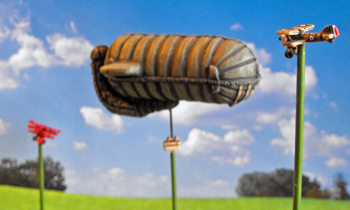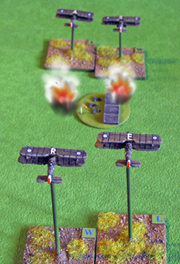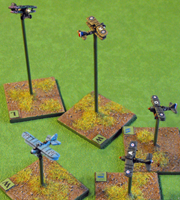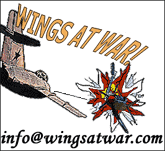The Western Front 1917-18
![]()
It was inevitable that the men in uniform would show a keen interest in the first successful efforts at flying. Within four years of the Wright brothers' inaugural hop the US Army issued the first specification for a military aeroplane. In 1909 H. G. Wells, the author of Little Wars, wrote about the future of the aeroplane in war "The victor in that aerial struggle will tower pitilessly watchful eyes over his adversary" and the Italian aerial theorist Giulio Douhet declared "a new weapon has come forth, the sky has become a battlefield".
 By 1911 the aeroplane had
been used by Italy to fly reconnaissance missions in Libya during
the Italo-Turkish War. Very soon Italian aeroplanes were being used
for artillery spotting and photo-reconnaissance. On the 1st November
the first bombs were dropped.
By 1911 the aeroplane had
been used by Italy to fly reconnaissance missions in Libya during
the Italo-Turkish War. Very soon Italian aeroplanes were being used
for artillery spotting and photo-reconnaissance. On the 1st November
the first bombs were dropped.
At the outbreak of war in 1914 all the major belligerents had fledgling air arms organised in units of mixed types. At first these were employed exclusively for reconnaissance, not because of any sense that using aeroplanes to attack the enemy was considered unsporting, but more due to the limited performance which precluded any meaningful payload. Individual pilots however, were not adverse to the odd adventure such as dropping bombs by hand. These soon developed into something more effective, including the destruction of a brand new airship when two Royal Naval Air Service aeroplanes bombed the airship shed at Dusseldorf.
Observation became increasingly important, as shown by the spotting of the vulnerable gap developing between the German 1st and 2nd Armies that led to victory for the Allies at the Battle of the Marne. Denial of airspace to the enemy developed to the point where pistols, rifles and the simple expedient of attempting to force your opponent down by aggressive flying, or even ramming, became increasingly common.
By 1915 the development of more powerful
engines meant that machineguns could be carried aloft, but there
still remained the problem of aiming the gun. The ideal solution
was to mount the gun in front of the pilot firing directly ahead
through the propeller so that the aeroplane was aimed rather than
the gun. The French came up with the simple, though not altogether safe, idea of fixing metal deflector plates
to the propellers to protect them from the bullets. The Germans
introduced a mechanical interrupter gear which stopped the machinegun
firing whenever the propeller was in the way. The latter was fitted
to a relatively small number of monoplane Fokker E.III Eindeckers intended to act as escorts for unarmed recce planes. However,
the more aggressive Fokker pilots such as Boelcke and Immelmann
soon realised the offensive potential of this new weapon and the
Allies were all but swept from the sky. Before his death a year
later Boelcke had used his experiences to develop a series of offensive
tactics for air combat that are still relevant today.
Not withstanding Allied tardiness and incompetence in producing improved types, the E.III's place in the sun did not last long. It was eventually superseded by better designs; biplanes which, with the limited technology of the day, produced far stronger aeroplanes with greater wing area allowing vastly improved manoeuvreability.
Lone reconnaissance planes would ply their trade along the front line, perhaps straying into enemy territory, taking photographs and spotting for artillery. These would be escorted by one or more fighters, with a squadron further back ready to lend support when required. This was the period of the solitary ace, able to stalk unnoticed ready to pounce, and then effect a rapid exit before the escort could intervene. Superior aeroplanes such as the Nieuport 17 and Sopwith Pup meant the Allies had the upper hand by late 1916.
By 1917 aeroplanes were being organised in to units comprising the same type, the most important being reconnaissance, followed by the bomber. The role of the fighter (or scout as they were generally known) was support for these two, and of course destruction of the enemy's reconnaissance and bomber planes. The importance of photo reconnaissance is illustrated by the 5,000 aerial photographs produced each day by the French. These could be processed and delivered to the troops on the front line within the hour. Though tethered balloons could spot for artillery, wireless equipped aircraft made artillery correction by aeroplanes far more versatile.
The German introduction of several dozen Jastas or 'Hunting Squadrons' with improved fighter types achieved complete aerial dominance over the Western Front and once again the Allies were swept from the skies. April 1917 became know as 'Bloody April' to the Royal Flying Corps.
The British fought back with better scouts such as the Camel, SE.5a and Bristol F.2B and the French with the SPAD VII and SPAD XIII. The Germans countered by massing their Jastas into the 'Flying Circus' able to temporarily swamp a sector of the front. The Allies, too introduced larger formations and the era of the lone wolf ended to be replaced by the massed dogfight. In the summer of 1917 the Germans formed Schlachtstaffeln, specialist ground attack units.
In 1915 both the Germans and French initiated concerted bomber raids against rear area and civilian targets, including one French raid of over 60 bombers. At first, unlike the Russians and Italians, the Western Front Powers did not posses aeroplanes large enough for strategic bombing. By 1917, after limited operations on the Eastern Front, the Germans used large multi-engine bombers against Britain and rear area targets in France. Later that year the RAF (the amalgamated RFC and Royal Naval Air Service) formed a strategic bomber wing with DH.4s in the daylight raiding role.
For the German's final offensive of the war in spring 1918 they massed nearly 1,700 aeroplanes against the British held part of the line, of which nearly a third were single-seat fighters. The RAF's strength consisted of 150 Camels, slightly more S.E.5as, 80 Bristol Fighters and 130 other scouts including SPADs and Nieuports. Planned air attacks by the RAF and French on troops and heavy weapons in or near the front line made a significant contribution to the battle, the Breguet 14 being particularly busy.
The Americans started to fly offensive patrols and many of their pilots racked up impressive scores, though Americans had already flown with the RFC and the French, most notably the largely American Escadrille Lafayette. As there was virtually no American military aviation industry the US Air Service was first issued with Camels and the Nieuport 28. Neither plane was liked by the Americans so they soon re-equipped with the SPAD XIII.
By coincidence the British counter-offensive in August was also supported by 1,700 planes, which included seven squadrons of O/400 heavy bombers. Despite the introduction of the superb Fokker D VII the Germans again lost the initiative, though in August during the most intensive period of fighting German fighters shot down 80 enemy aircraft in a single day for the loss of 49 of their own number.
By the end of the war the largest air force on the Western Front was the French with over 4,500 machines. The RAF was many times larger but scattered all over the globe. The US contributed another 1,500. Facing them the Germans could still muster 2,400 combat aeroplanes.
 The war had started with a hodgepodge of
types organised on a more-or-less random basis and with little clear
idea on tactics or doctrine. By the end aeroplanes operated in homogenous
formations with clearly defined roles. Strategic bombing and close
ground support were commonplace, the Germans were even toying with
the idea of radio-guided bombs. Fighters employed a series of tactics
and manoeuvres that would be familiar to the fighter pilots of today.
The first World War saw not just the planting of the seed, but the
complete maturity of the roots of modern military aviation. Through
war, Man had conquered the sky.
The war had started with a hodgepodge of
types organised on a more-or-less random basis and with little clear
idea on tactics or doctrine. By the end aeroplanes operated in homogenous
formations with clearly defined roles. Strategic bombing and close
ground support were commonplace, the Germans were even toying with
the idea of radio-guided bombs. Fighters employed a series of tactics
and manoeuvres that would be familiar to the fighter pilots of today.
The first World War saw not just the planting of the seed, but the
complete maturity of the roots of modern military aviation. Through
war, Man had conquered the sky.
Click on the links below for more information
